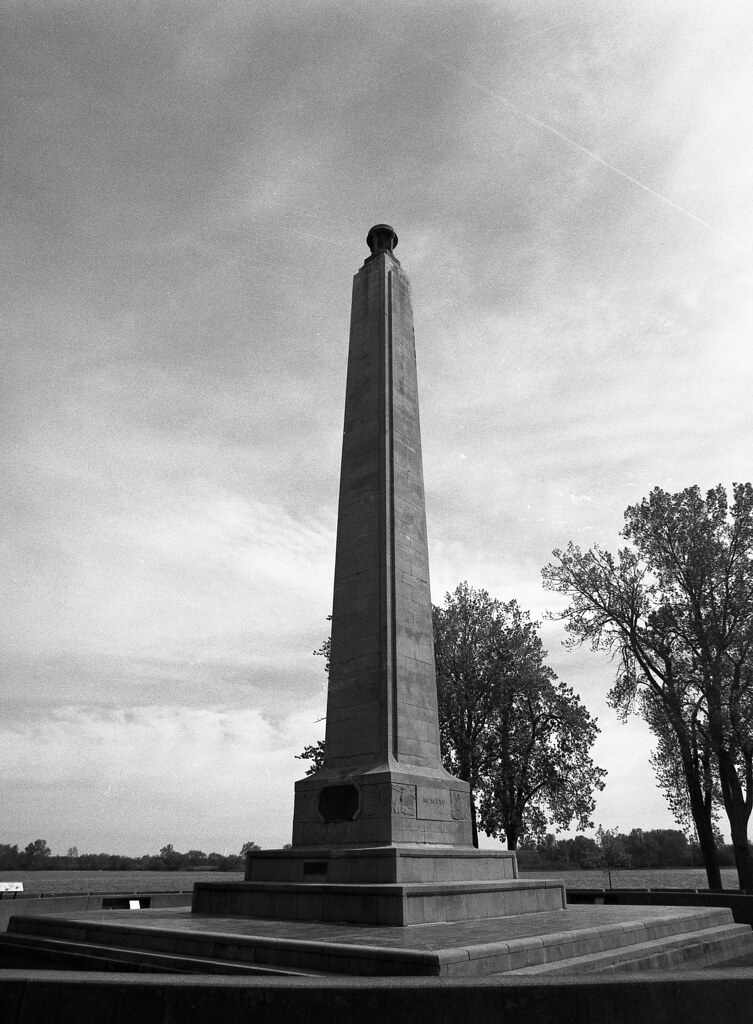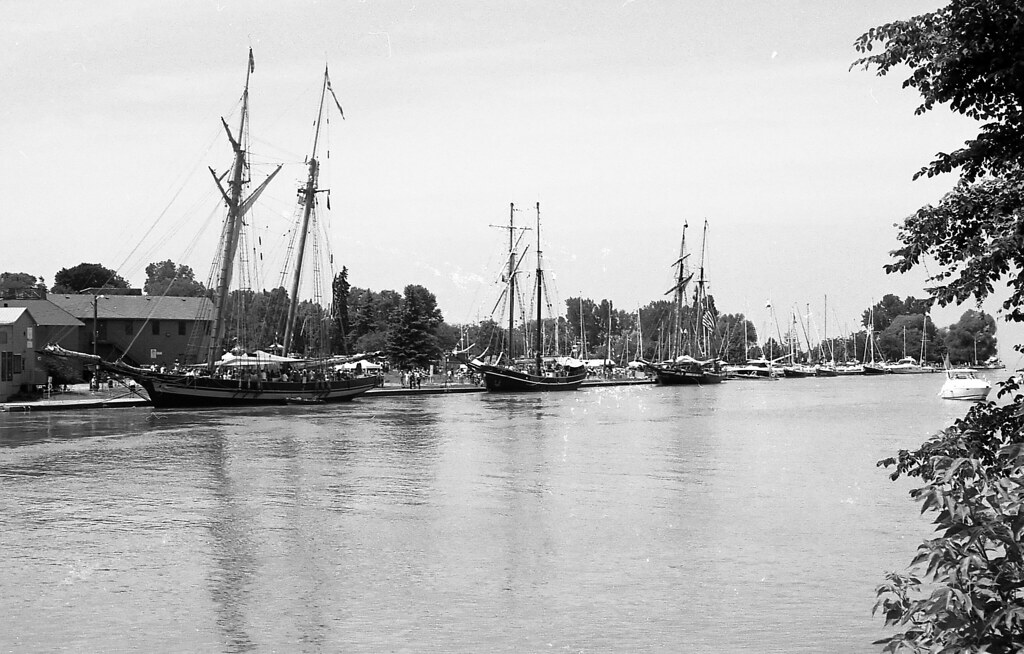When it came to naval warfare in the 19th century the undisputed masters of the sea was the Royal Navy. The rivers and lakes of Upper and Lower Canada were the highways of the day, these were the main trade routes not only for economic purposes but military as well. Any nation that controlled the waterways, could control the course of the war. With the United States not having a squadron of note on the Great Lakes at the start of the war the British were quick to seize control of both Lake Ontario and Lake Erie. With Brock’s capture of Detroit in August of 1812 the British had undisputed control of Lake Erie. The Royal Navy, supported by the Provincial Marine moved freely sending supplies and troops while being supported by bases at Amhurstburg, Fort Norfolk (Turkey Point), and smaller ports along the south western coast of Upper Canada. The Americans were effectively blockaded. But in January 1813 construction began on a squadron that could engage the British. Construction of two brigs along with four gunships was started at Erie, Pennsylvania at the newly established Presque Isle navy base. In March of 1813 command of the base and the squadron was given to the young rising star of the US Navy, Oliver Hazard Perry.
A note on nomenclature: the terms HMS and USS were not in common use during the 19th century, rather the ship would be referred to as what type of ship it was. So the Detroit, being a Sloop would be known as His Majesty’s Sloop Detroit, or H.M. Sloop Detroit, similarly a ship in the United States Navy would be the United States Brig Niagara or U.S. Brig Niagara. The number in brackets following the ship’s name indicates the number of guns mounted. So H.M. Sloop Detroit (20) is a 20-gun Sloop in the service of the Royal Navy named Detroit. For reading ease, when I first introduce a ship I will refer to it in this manner, and then every following time simply call it by name.

The statute of Master Commandant Oliver Hazard Perry in Downtown Erie, PA
Pentax 645 – SMC Pentax A 645 35mm 1:3.5 – Kodak Tri-X Pan (320TXP) – Kodak HC-110 Dil. B 5:30 @ 20C
However both the British and American squadrons were undermanned, relying on infantry and militia to crew the boats. Perry took matters into his own hands and went to visit Commodore Chauncy, the commander of the American Lake Ontario Squadron in May of 1813. Chauncy pressed Perry to assist in the ultimately successful attack against Fort George and seizure of the entire Niagara Peninsula. Once the campaign was complete, Perry returned with hardened sailors, and in a brilliant feat moved two gunships over land to avoid the British patrols on Lake Erie. Meanwhile Perry’s opposite, Commodore Robert Barclay was given command of the British Squadron. Barclay was forced to move men of the 41st and Royal Newfoundland regiment to crew his squadron while waiting on the H.M. Sloop Detroit (20) to be completed and armed. Colonel Procter was not pleased with this, as he was already stretched thin for troops as it was. It was this lack of troops and supplies that kept the British from attacking the Presque Isle navy base catching the incomplete American Squadron before it was finished. But the arrival of two captured American ships from Fort Mackinac and men allowed Barclay to maintain an effective blockade of the American squadron. However with supplies running low, and poor weather, the British were forced to lift the blockade on July 24th, 1813. Perry’s squadron now complete took advantage of this and began to move the squadron into open water. Removing the guns from the ships first, the ship’s crews used a system of barges to lift the ships over the natural sandbar in the harbor, then rearmed the ships. Barclay returned in August, only to find Perry’s squadron lining for battle to meet him. Rather than attack without the Detroit, Barclay withdrew to Amhurstburg. Perry put to sail to Put-In-Bay. The tables had been turned, and now it was the British who were blockaded in their home ports.

Perry’s Monument at La Presque Isle
Pentax 645 – SMC Pentax A 645 35mm 1:3.5 – Kodak Tri-X Pan (320TXP) – Kodak HC-110 Dil. B 5:30 @ 20C
By September the situation in the British camp had come to a head, several disastrous attempts at breaking into the Northwest in the summer had ended in failure and with supplies running low, the only option was to break the American blockade, and Barclay set out to face Perry in battle. The British squadron had six ships, Barclay’s flag was on the now complete Detroit. Supporting the flag ship was the H.M. Sloop Queen Charlotte (16), H.M. Schooner Lady Prevost (13), H.M. Brig Hunter (10), H.M. Schooner Chippeway (1), and H.M. Sloop Little Belt (3). Perry on the other hand had nine ships, his flag ship the U.S. Brig Lawrence (20) (named for the commander of the U.S. Frigate Chesapeake, a personal friend of Perry). Supporting the flagship the U.S. Brig Niagara (6), U.S. Sloop Scorpion (4), U.S. Schooner Somers (1), U.S. Schooner Porcupine (1), U.S. Schooner Tigress (1), and U.S. Sloop Trippe (1). While Barclay had the advantage in guns and big ships and long range fire. Perry’s plan was to get within close range where his two big ships could do the most damage, armed mostly with carronades (deadly short range naval guns). On the morning of September 10th, 1813 the American squadron spotted the British squadron on the horizon. Perry ordered the squadron out to close for battle. Barclay, the weather in his favour opened fire with his long range guns at 11:45am, getting the better of the American squadron, but as the weather turned to the American’s favour, Perry closed to point blank range and began to pound at the British squadron, his other big ship, the Niagara however was slow to engage, and hung back. By 12:15 the two fleets were locked in close range combat, the carronades on the Lawrence dealing a great deal of damage into the British squadron. However without the support of the Niagara, the Lawrence was getting cut to shreds herself. With crew losses at 80% Perry made the decision to transfer his flag. Perry had himself rowed to the still intact Niagara, and took command of the squadron from there. He sent his second-in-command, Lieutenant Jesse Elliot to get the lagging gunships back into the fight, and put the Niagara on course to take on the British squadron. In an attempt to flank the Niagara the Detroit and Queen Charlotte collided, their rigging entangled giving an easy target for the Niagara’s gun crews. While the American gunships came into the action and began to take care of the smaller British ships in the squadron. With most of the British officers killed or seriously wounded, command of the squadron fell to a Provincial Marine Lieutenant. The British expected the Niagara to run, but instead Perry continued to fight, with a majority of the squadron damaged or unable to fight, they surrendered at 3pm on the 10th. Perry, triumphant, returned to the deck of the now recaptured Lawrence, to accept the surrender of Commodore Barclay. Perry took the surrender on the Lawrence rather than the Niagara as to allow the British to see what the American victory had cost.

An Example of an American Carronade, Perry’s preferred naval gun aboard the U.S. Frigate Constitution (44)
Rolleiflex 2.8F – Carl Zeiss Planar 80mm 1:2.8 (Green) – Kodak TMax 100 (100TMX) – Blaiznal (1+25) 6:00 @ 20C
“We have met the enemy and they are ours,” Perry penned in a letter to General William Henry Harrison. Perry’s action had resulted in the capture of the entire British squadron. The British suffering 41 casualties, 93 wounded, and 306 men taken as prisoner. The Americans lost 29 men and 41 wounded. The smaller ships were quickly repaired, and pressed into service. The Detroit, Queen Charlotte, and Lawrence were converted to hospital ships, repaired at Put-In-Bay, and then were used to transfer the dead and wounded to Presque Isle. The loss of Lake Erie to the Americans was the turning point in the western theater of the war. Perry’s squadron ferried 2500 troops across the lake to effect the capture of Fort Amhurstburg while Fort Detroit was taken by General Harrison’s army of the northwest by the end of September. The British were effectively removed from western upper Canada by October after the defeat at the Battle of the Thames.

Sailing ships typical to those used during the battle of Lake Erie
Nikon FM2 – AI-S Nikkor 50mm 1:1.5 – Kodak Tri-X 400 (400TX) – Kodak HC-110 Dil. B 4:30 @ 20C
The Detroit was commissioned into the US Navy as the U.S. Sloop Detroit, but was badly damaged and sold out of the service in 1825. The Queen Charlotte, much worse in condition than the Detroit, was laid up in Put-in-Bay until 1825 when she was sold out of the service and converted into a merchant vessel. The Lawrence was repaired and returned to the service in 1814, and at the end of the war was sunk at Presque Isle in 1815. Her hull was raised for the centennial celebrations in 1876 and was put on display in Philadelphia. A fire later that year destroyed both the pavilion and the Lawrence. The Niagara was also sunk in 1815, but in 1913 was raised and fully restored for the centennial celebrations of the Battle of Lake Erie. However she was soon found to be unseaworthy and was dismantled, the United States Brig Niagara is a faithful modern reconstruction using parts from the original ship. The Niagara now tours the great lakes, and offers training programs for people interested in learning how to sail. Monuments to the battle can be found at Put-In-Bay, OH, and at Presque Isle state Park in Erie, PA. Statues to Perry can be found in Buffalo, Cleveland, and Erie.
Written with Files from:
Collins, Gilbert. Guidebook to the Historic Sites of the War of 1812. Toronto: Dundurn, 2006. Print.
Hickey, Donald R. Don’t Give up the Ship!: Myths of the War of 1812. Urbana: U of Illinois, 2006. Print.
Web: http://militaryhistory.about.com/od/navalbattles1800s/p/lakeerie.htm
Web: http://www.eighteentwelve.ca/?q=eng/Topic/35